Wandering Around Out There With A Canoe On My Head
Wandering Around Out There With A Canoe On My Head
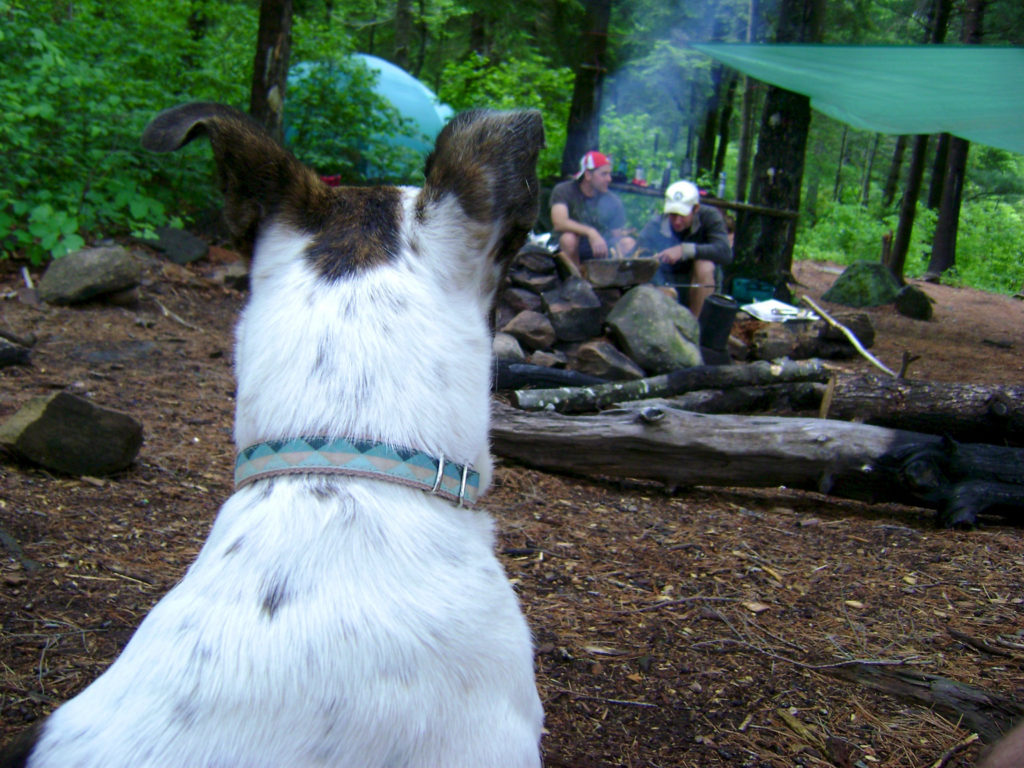
The Plan
Taking beginners into the wilderness has its own set of challenges. Do they know what they’re getting themselves into? How much will they enjoy themselves? Are they expecting a Survivorman experience or more akin to sipping tea in a remote cottage? On the other hand, there are some really great rewards to introducing the beauty of the outdoors to someone. I imagine it’s very similar to the rewards of a teacher seeing a child finally get enthusiastic about learning. Usually you get at least one of these moments per trip, but you have to watch for them because it can be very subtle.
This summer I took a small corporate group out on a portage trip, which they hoped if all went well would become an annual event. First, I decided on travelling through Algonquin, mainly because of its fame – they could tell stories about their “Trip to Algonquin” with most people being able to relate. Second, Algonquin offers a lot of options for different levels of portaging experience, and has all the amenities of a provincial park (i.e. privies). I looked for a route that would give a nice authentic experience.
Of course there was also the selfish aspect, in that I generally like to cover as much new ground as possible. So I began starring at a map of Algonquin Provincial Park trying to figure out a 3-day route that wouldn’t be too difficult, but was challenging enough, and that I haven’t been (at least recently). I read somewhere, that in a season and a half ago the park had done cleared some normally unmaintained portages going into McCraney Lake from Islet, which must have been in the back of my mind while I searched for a starting point that wasn’t too far in which to travel. They decided on a 3-day trip, and I didn’t want to waste too much time travelling back and forth from the put in. Perfect. This would be a great way to travel a pretty unique route without too much trouble, and being on the south western side of Algonquin, we wouldn’t have to travel far to get there. Of course, as with any unmaintained portage, I really didn’t know what I was leading us into.
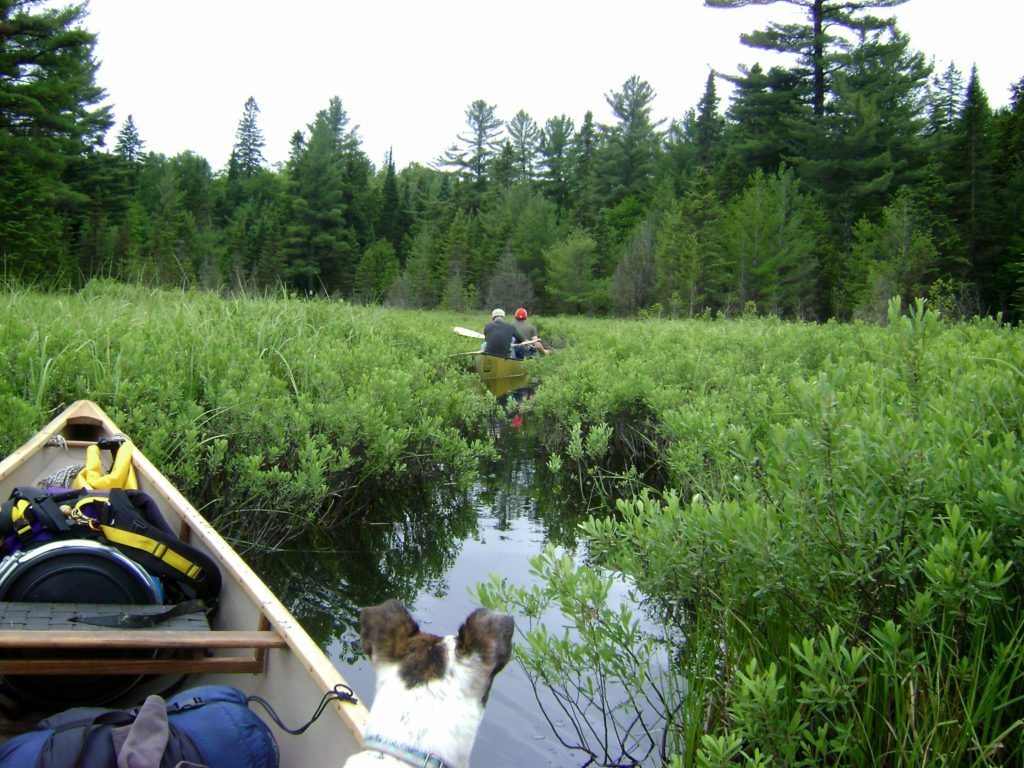
Heading Out
So as not to waste too much of the 3 days on travel, we left right from the office at quitting time the night before our trip to Arrowhead Provincial Park to stay the night (hwy 11 just north of hwy 60). From there it was a 40 minute drive into the town of Kearney to get our permits and meet the outfitter. To get there, travel north from Huntsville on hwy 11 until just before the town of Novar, exit onto hwy 518 which will twist and turn until you reach Kearney. Turning right on Main Street, the permit office is immediately on the left, and the outfitter, Trailside Adventure Co., is a block down the street.
I can’t say enough good about this outfitter. He took care of us very well, was very personable and no-nonsense. He rented us brand new Souris River Le Tigre canoes that had never been used before. I felt the need to explain to the group how rare that was, and how great these canoes were, so that they’re not too disappointed when they don’t get the same when next they rent a canoe. The outfitter even talked one of the group out of buying a sleeping pad, instead suggesting to rent one and if they still wanted to buy it, he would sell it to him less the rental cost.
From the outfitters, it’s still another 45 minute drive to Rain Lake. However, if you’re interested in one last meal before living off astronaut food and trail mix, you have got to stop by the Bayside Bistro. It’s just a little place – nothing fancy – further down Main street, but you’ll be thankful that you did. In fact, on the weekend we went, the Toronto Star had featured them in the weekend edition (I’d include a link to the article, but I couldn’t find it online).
Once you’re filled, head up Rain Lake road and it will take you right to the put in. The road slowly gets rougher as you get closer to the park, but once there you’ll find a nice little beach for a put in – equipped with a little dock – with plenty of room to drop your gear and a lot further back with plenty of room to park.
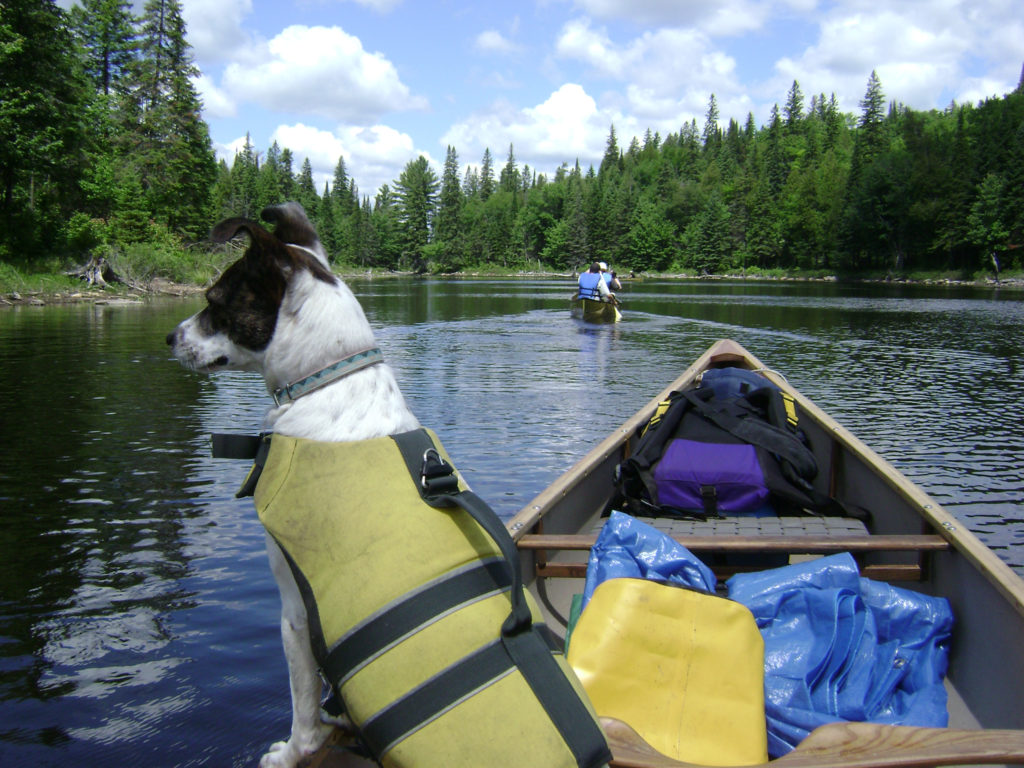
The Trip begins (Day 1)
Because this was the first time portaging for most of the group – in two cases the first time in a canoe – I had planned to give a little instructional demo, but the enthusiasm of it all had them all jump in their canoes and off by the time I had parked my car. It was a good sign. You never know how well people would enjoy this type of activity until they’re out there doing it.
We made our way east along Rain Lake towards our first portage in a great looking day. It’s about 5km of paddling through what appears to be a wide river rather than a lake. Our group consisted of myself and Nancy in one boat, two athletic types in another who were consistently ahead of the rest of us, and a couple in the third canoe. These two had never been in a canoe before and were going through a voluntary trial by fire method of learning to paddle. I’ve heard – often – the expression that if you wanted to convince a couple to divorce, have them learn to paddle a canoe together, and for the first little while I thought I was seeing that in action.
Like a lot of beginners, they weren’t really comfortable at first, thinking even the slightest movement would send them overboard. They were also getting a little frustrated with each other over their roles in steering, navigating and controlling the canoe – not to mention which side each of them should paddle – all the while zig-zagging along the water. This is very common. As we paddled along together I tried my best at sneaking in a few bits of advice – the most important being a reminder that they were on vacation, and we had plenty of time to get where we were going. Thinking I was helping, I even demonstrated how (relatively) difficult it actually is to tip the canoe by rocking my canoe back and forth. Unfortunately that just seemed to freak them out more than it helped. Nevertheless, by the time we got to the portage everyone was a lot more comfortable and ready for our next challenge.
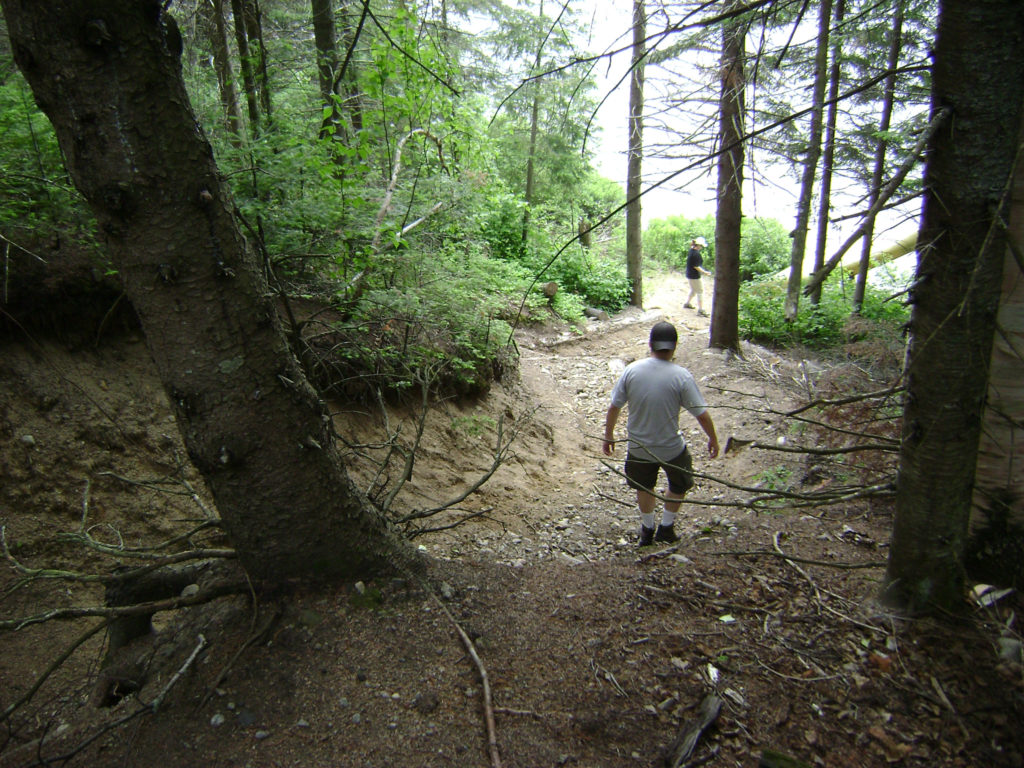
The First Portage
The portage into Hot Lake is a relatively easy 700m trail with a steep first and last sections. Everyone was eager to carry as much as they could across, and as we walked I really started to get a sense that everyone was enjoying themselves. It’s funny because anyone who hasn’t portaged goes through different stages. At first they’re eager when planning the trip, then as the trip gets closer – especially as the portage itself gets closer – they worry about having to lug all that stuff across. Often they get their packs on their backs and really think they’ve made some huge mistake in agreeing to the trip. After a few meters, they might think about how long the portage is and confirm that they had. But as you start moving along and the surrounding nature gets a hold of them, they start thinking about how this really isn’t so bad, that they can do it. Once you see the water on the other side you get a surge of energy knowing that it’s just about done. The best part is the moment you get to the end of the portage and see the lake at which you’ve arrived. Once the pack is set down and you have a little rest, that’s when the sense of accomplishment sets in. And so it was with this group as they eagerly got into the canoes without a complaint among them, ready for the next portage.
Hot Lake is a 500m or so before you get to the next portage, a short 495m trail that rises and falls 50ft in that short distance, but is otherwise an easy well travelled trail. In no time you’re on Lake Islet, a nice sized, crystal clear lake surrounded by tall pines, with plenty of secluded campsites. The one we were looking for was an island site right in the middle of the lake. I prefer the island sites, probably for the same reason kids build forts and tree-houses: it’s a fun little exotic space you can call your very own. This site was a nice one with plenty of room for tents and a nice big flat area for the campfire. The group unpacked and began to relax around the campfire. What was setting in was both the untouched beauty of the area and the feeling of just how far you were from “civilization”, and everyone expressed how cool that was in their own way. Everyone seemed to be having a great time.
The problem at this point was the upcoming weather. Nothing will suck the enthusiasm away from you than a little cold and rain. The weather report suggested that it was going to get really wet overnight, and into the next morning – at least. Everything’s easier when it’s sunny out, and people’s moods reflect that, whereas the exact opposite is true when the weather turns. I crossed my fingers going to bed that the rain would come and go, and if not, everyone would deal with it well.
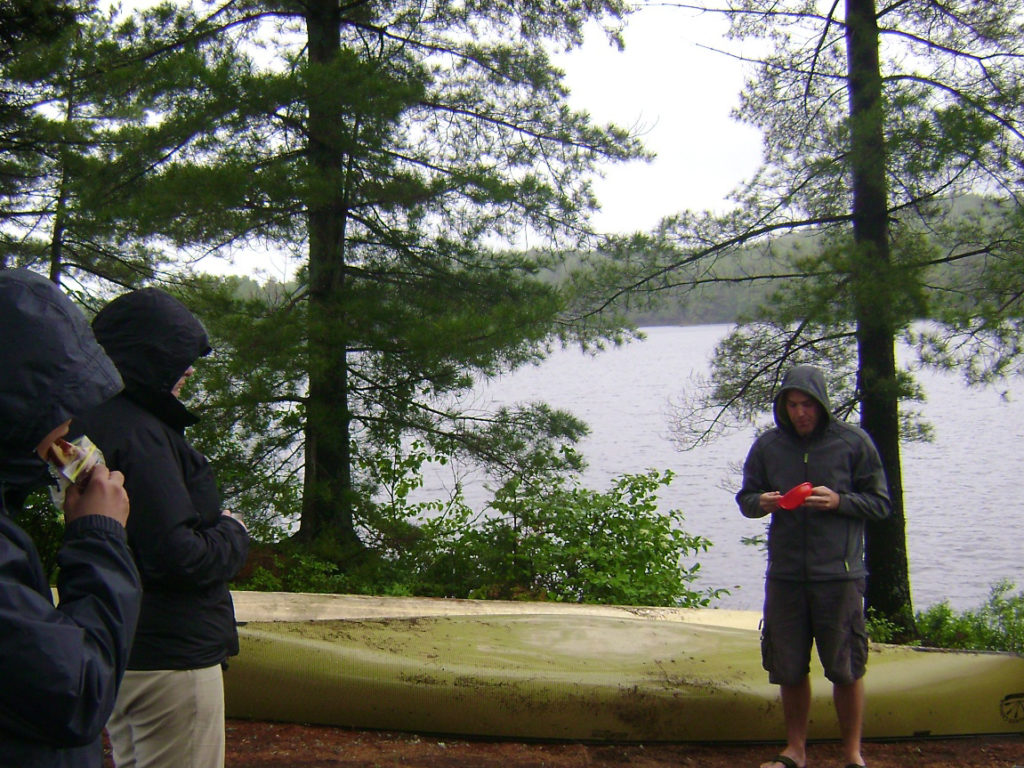
And then the rains came
I woke the next morning to the sounds of really heavy rain bouncing off the tent, (Doh!) where I stayed until it began to let up a bit. (One of the great camping dilemma always surfaces in this moment. I don’t want to go out there and get wet, but the sound of all that rain sure makes me want to go!) The group gathered around the campfire and set up a tarp while we ate breakfast. The sky was ugly looking with no signs of better weather ahead, and I didn’t know how that would affect the group’s attitude. Surprisingly, there was no talk about going home, or trying to stay here for the day or any other negative ideas. I wouldn’t say everyone was enthusiastic exactly, but we packed up as planned and headed out for the day ready for whatever adventure the day had in store.
Travelling in the Rain (Day 2)
Day 2 began with a wet 1km paddle south down Islet Lake to a very short 45m portage into Weed Lake, where it stopped raining after we crossed. The beauty of a rainy day can often be overshadowed by the weather, but Weed still offered a great view of the untouched forest on a very calm lake as we paddled southeast along the 1.6km distance of lake.
The 635m portage to cross over into Way marked the spot where we would enter into the “unmaintained” area of the park. What this means is that while the park acknowledges the trails, they do not routinely clear and maintain the portages and so they are “use at your own risk”. The normally yellow portage markers even turn white to express the t
hought. Especially now with the dark skies and potential rains, the group’s enthusiasm might be put to a real test. A bad sign was the water bushes we needed to cross through slowly and carefully getting to the portage start.
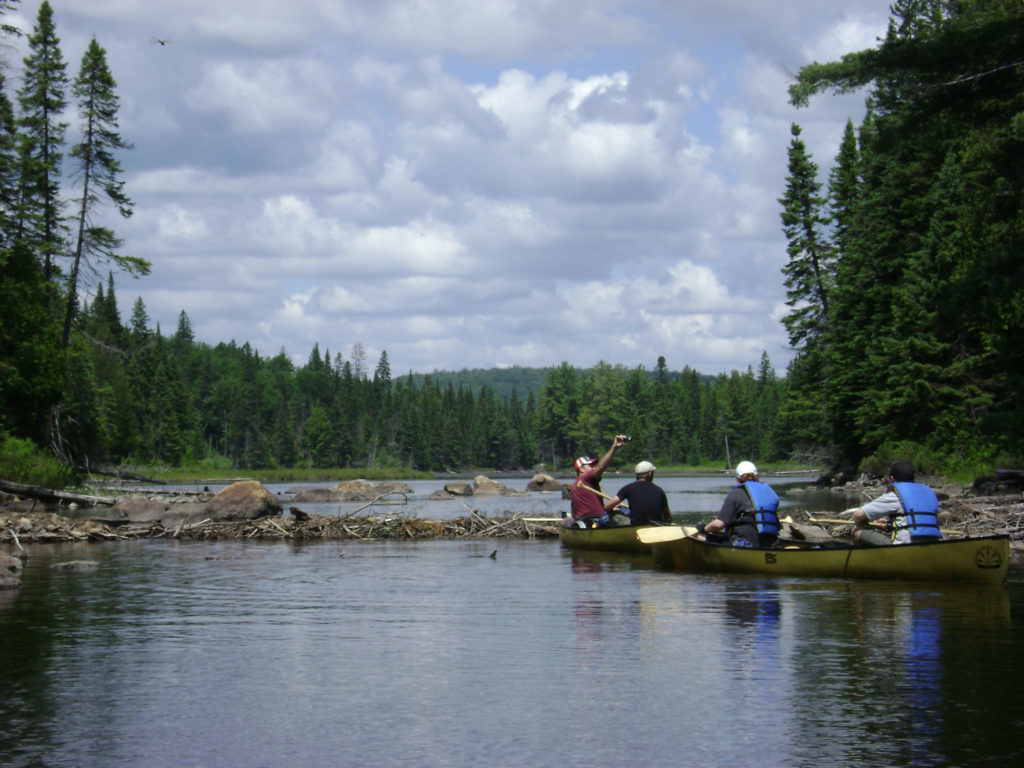
Unmaintained Portages
The portage was a little rough, with some steep parts with very slippery rocks hidden under leaves, and a few logs we had to climb over or under, but all told it was a pretty standard portage if you watched your step. Once across into Wee lake it’s a very short paddle (165m) to the next portage into Way.
Shorter than the one before (570m), this portage was very similar, but it becomes clear that your travelling downhill on this route as the steep end of the portage requires a little bit of attention so as not to slip. Once at Way Lake – yeah, we just travelled from Weed to Wee to Way like an adventure in a fairy tale – it’s another short lake (200m) to the next portage. These short breaks between portages can often be a little disheartening. I often feel that way when you can clearly see the next portage marker from the last. These beginners did not feel that way at all knowing this portage crossing into McCraney Lake would be short (65m) and the last for the day.
McCraney Lake
We entered McCraney Lake into a small protected bay and the skies were still pretty dark. We would have to hug the shore as best as we could to be safe from a quick turn in the weather. When we turned south at the widening of McCraney Lake we all had one of my favourite experiences: The horizon opened up to reveal a huge island – our destination – in the distance. This feels like a typical scene in many movies and books where the heroes travel a great distance, undergoing adventures along the way only to get a first sight of their destination in the distance – usually some huge castle or mountain where their journey will come to an end. Okay, so our adventure wasn’t as dramatic (no wizards, rings or knights), but it’s still pretty cool.
Again we stayed on another island, a choice that would add a few kilometers to our trip but it was worth it. This island was much bigger than the last offering a wide variety of soft, flat tent spots, a huge campfire area, and a view to the west and the sunset. We were lucky that the weather had held up, and were hoping the skies would clear somewhat for a nice sunset view. Slowly, they did clear for a beautiful evening – with some nice pink skies to hopefully tell us a nice day would follow.
It was at this time that I got one of moments I mentioned earlier. Staring out into the clearing sky, overlooking the rocks and trees in the distance, a member of the group looked at me and said “Two years. Two years you have to take me and my kids out here. They should be old enough then, and this is just too cool not to share with them”. I agreed.

What’s in a number? (Day 3)
Sure enough Day 3 began very clear and beautiful, with loons greeting the morning sun. With all our gear now dried, breakfast talk was about today’s challenge: a 1700m portage that would take us back home. I have said many times that portages always travel over the easiest path from one lake to the other. This means that if they’re longer than it seems they should be, it’s because it’s the easier path (flatter, less obstacles etc.). The group seemed to be comforted by this thought, but what I didn’t mention was that “easiest” is of course a relative turn – sometimes they’re long because it’s the only way across a lake. I did read before the trip that this portage was very flat, but again that too is a relative term. And besides, the portage didn’t have a name, a sure sign that it wasn’t tough. I guess what I’m saying here is that having never had crossed this portage, I didn’t know what lay ahead, but didn’t want to worry everyone about a big number all morning.
We set out for Day 3 on a beautiful morning with a slight breeze. It was just over a 4km paddle to our first and only portage of the day, but at around the 3km mark we hit a lift-over – a small beaver dam dividing the narrow section of the lake. This is where I had another one of those moments.
The Lift Over
“What is this? A beaver dam?” said a member of the group, “Are we going to cross over this? How cool is that! Who would ever had expected to be on top of a beaver dam in the middle of the afternoon.” The group made sure we took several proud pictures of everyone standing on the dam. “This,” another member of the group said, “is hardcore”. I smiled to myself thinking about how well that experience went, and also how unusual a reaction that was to what is normally considered a surprise nuisance.
The long portage
When we got to the portage their was a lot of talk about strategy. Having experienced portages of the last couple of days, the common thought about one-timing a long portage (thinking that would be easier) was dropped quickly. The group would go as far as we could comfortably, then turn around and get the rest of the gear. As the portage began it looked like it would be a much more mild trail than those on the last days, but still seemed daunting because of the distance. However at about the 200m mark the portage turned suddenly into a a well groomed path like one you’d see in a city park. It turned out to be one of the easiest portages I have ever done. It was a beautiful walk under some really tall pines. When we reached the end I watched the group set out like pros, all agreeing how easy that portage was.
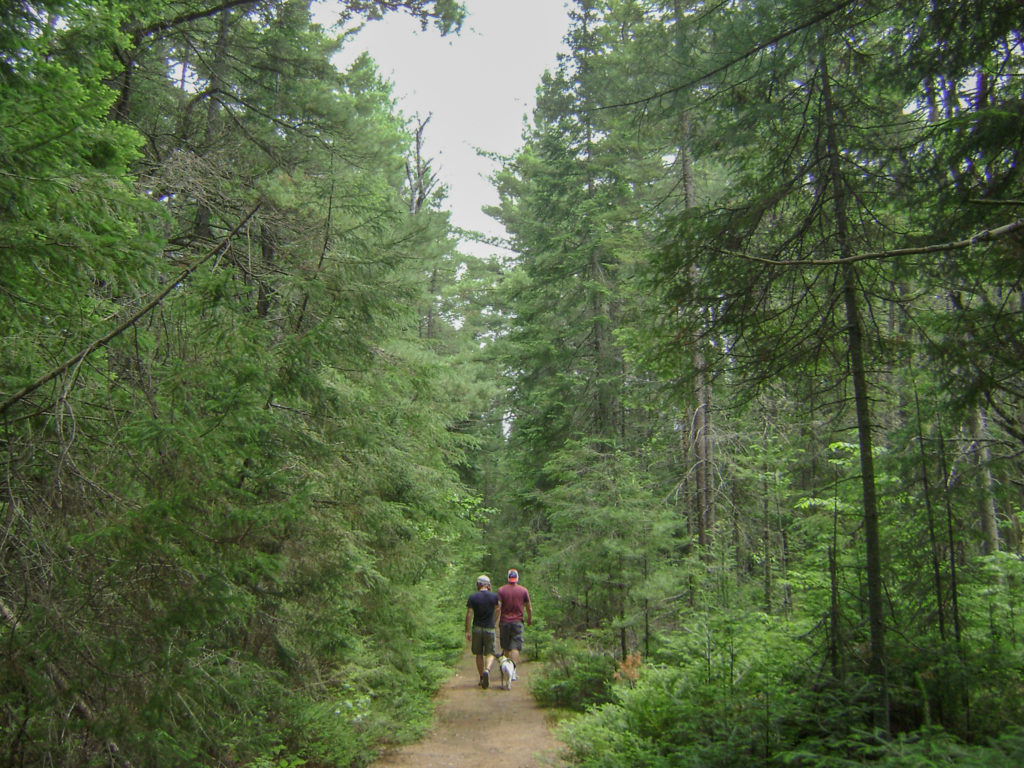
The Paddle Home
The weather remained great as we paddled the 2km or so back to the trip’s put in. It was a great trip, and it was pretty clear how much fun everyone had, with a great memory to share and maybe even motivate them to get back out there next year. More to the point they had a great story to tell. The time they went portaging in a lesser used area of Algonquin, along some rough unmaintained portages, getting rained on and having to do a 1.7km portage to get back home. A definitively Canadian experience.
I was told a few weeks later that the couple had become inspired by the trip and while not particularly eager to canoe by themselves, are regularly spending their afternoons hiking in different parks and have started on a plan to walk the entire Bruce Trail – so I suppose I had at least three of those moments on this trip.
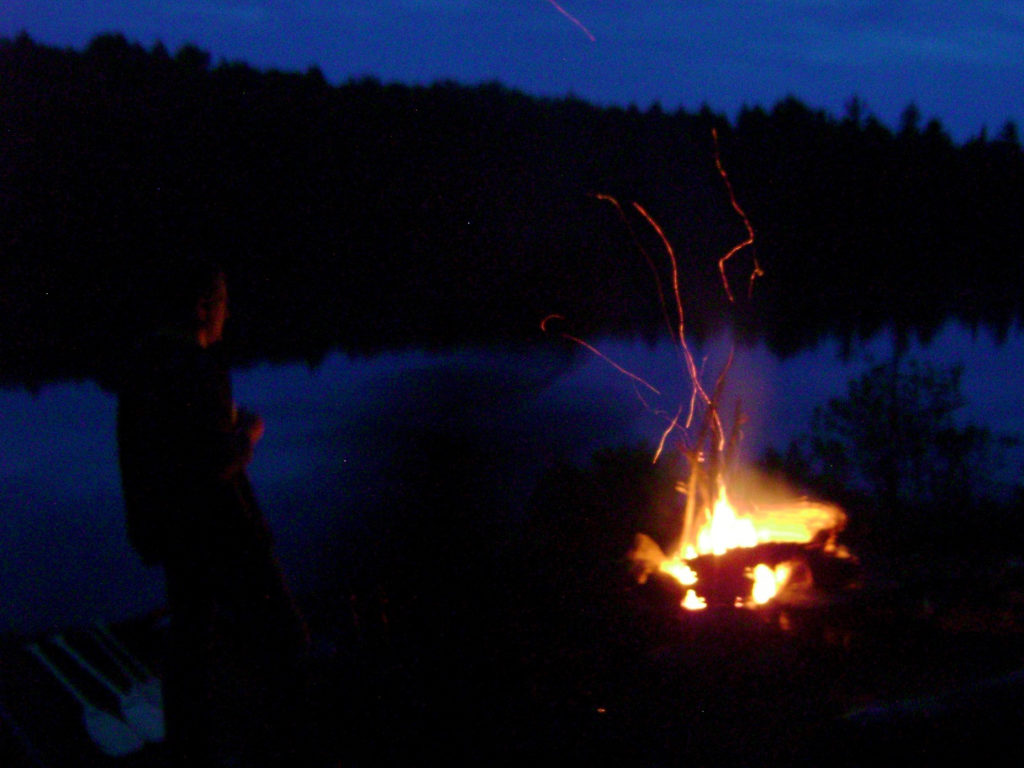
Nancy Postscript:
Nancy isn’t a big fan of water, whether it’s being immersed or it raining down on her, so she wasn’t the happiest I’ve seen her on Day 2, but once she dried she was back to her usual self keeping us squirrel free. One paddler didn’t take too quickly to Nancy at first, but somehow bonded with her along the way enough that on the last night was specifically cooking up the remaining hot dogs for her – even cutting them into little pieces in a little bowl and blowing on them so that they’d cool quicker.
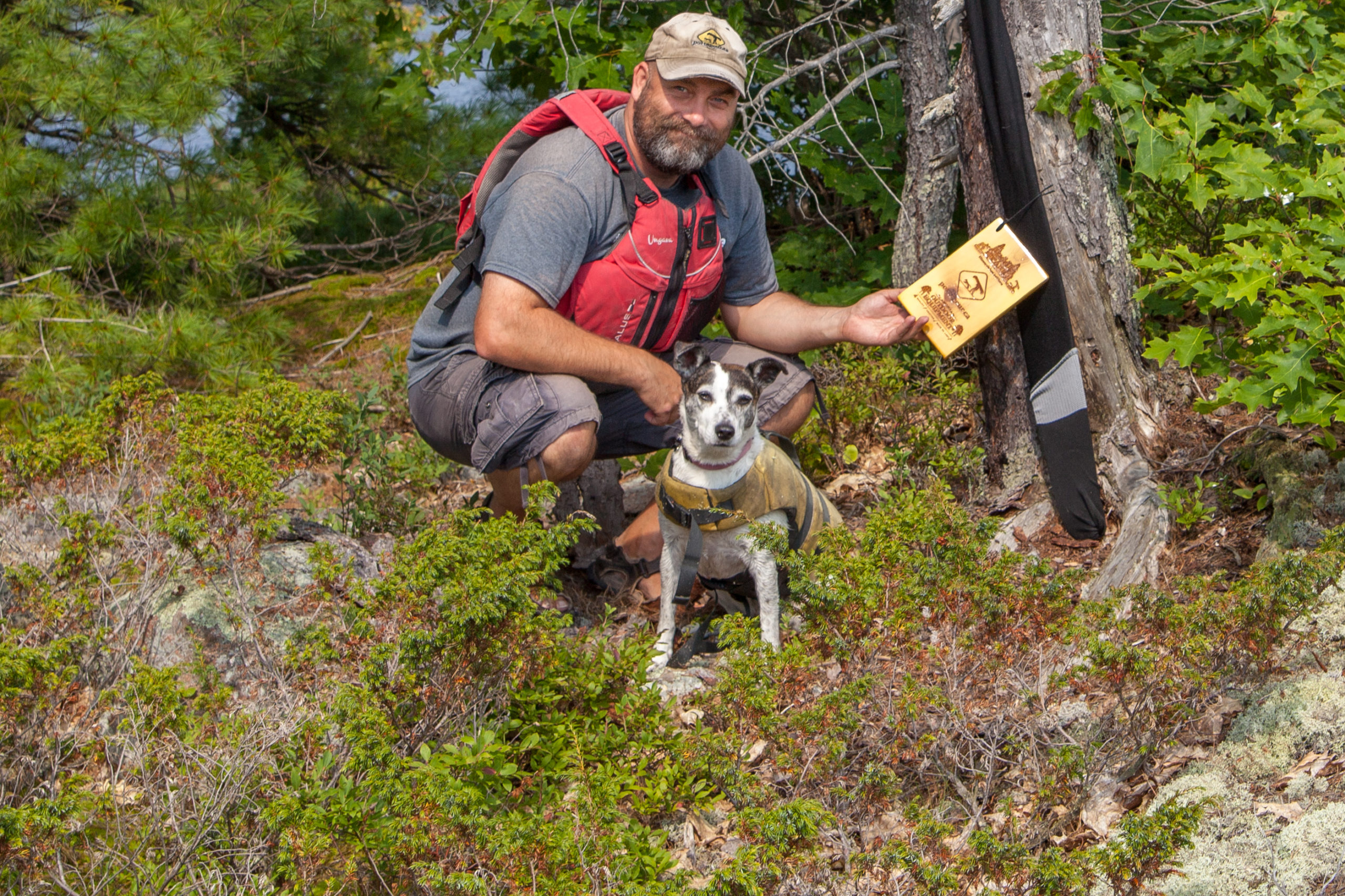
Session expired
Please log in again. The login page will open in a new tab. After logging in you can close it and return to this page.
Liked your post, FYI the portage from mcraney to Rain is down an railway spur hence it is flat.
Great post, Been to Rain, Hot, Islet and weed! Heading off to spend a week on Rain Lake this sunday!
-Cheers
Great post! Read it in anticipation of my weekend trip Sept 29-Oct 1 2012. Am hoping I’m going to nail the fall colours at peak on this trip. Will return with any comments and updates about the route, seeing as you wrote this 2 years ago.
I think you’re right about the peak fall colours, Gavin. I’d love to hear any updates about the route, thanks. Have a great time!